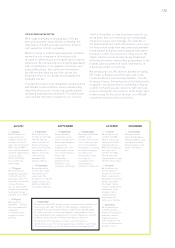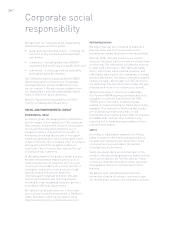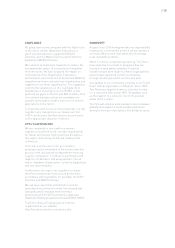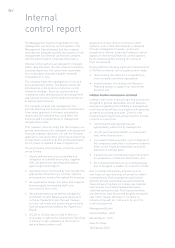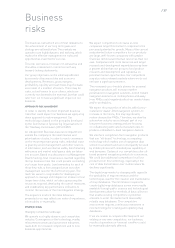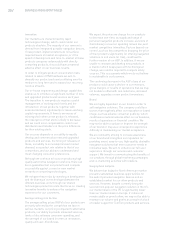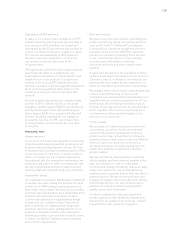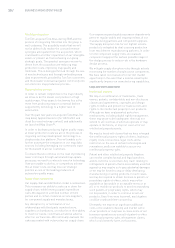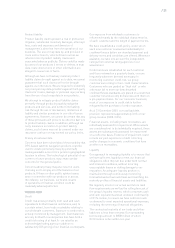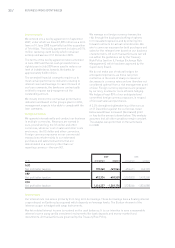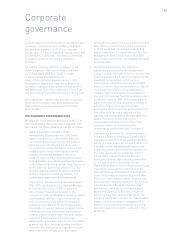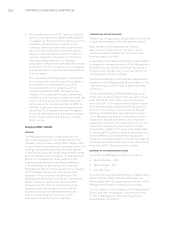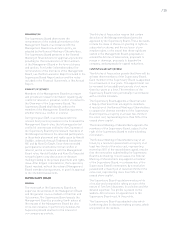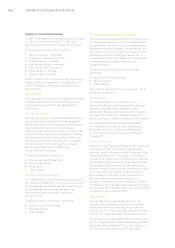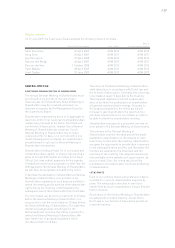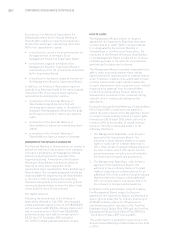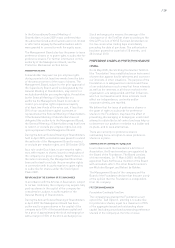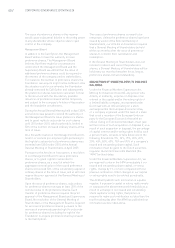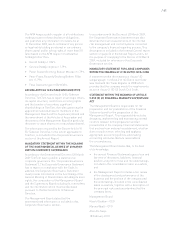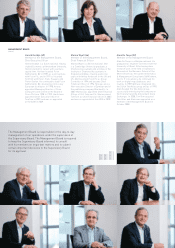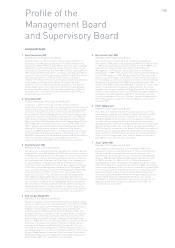TomTom 2009 Annual Report Download - page 35
Download and view the complete annual report
Please find page 35 of the 2009 TomTom annual report below. You can navigate through the pages in the report by either clicking on the pages listed below, or by using the keyword search tool below to find specific information within the annual report./ 33
TomTom takes its commitments to all stakeholders
seriously – consumers, shareholders, employees
and business partners. In all of our corporate
transactions our aim is maximum transparency and
accountability. In this light, TomTom is committed
to, and monitors, its corporate governance
structure.
As a listed company, TomTom is subject to the
Dutch Corporate Governance Code, published
on 10 December 2008 (the “Code”), a copy
of which can be downloaded from
www.commissiecorporategovernance.nl. Our
Management Board and Supervisory Board have
strived to comply with the guidelines laid down in
the Tabaksblat Code, the predecessor of the Code
and will continue their efforts to comply with the Code.
Any substantial change in the TomTom corporate
governance structure shall be explained to the
shareholders at an Annual General Meeting of
Shareholders.
THE CORPORATE GOVERNANCE CODE
We apply all of the relevant provisions of the Code
with the following deviations which, together with
the reasons for these deviations, are set out below.
1. Options granted to members of the
Management Board under the 2005 Share
Option Plan prior to 31 December 2005 vest
unconditionally and can be exercised after a
three year period following the grant date.
No predetermined performance criteria were
established for these share options, as the
industry of personal navigation was at a
relatively nascent stage and we believed that
setting credible (pre-determined) performance
criteria was not practical at that time. This is not
in line with best practice provision II.2.4. that
provides that the number of options granted
shall be dependent on the achievement of
challenging targets specified beforehand.
The TomTom Management Board Stock Option
Plan 2009, as adopted by the General Meeting
of Shareholders in April 2009, is aimed at
attracting and retaining key talent to the
company in order to safeguard its human capital
and aligning TomTom’s long-term incentives
with common practices within international
companies operating in the technology sector.
The number of options that vest is subject to the
achievement of pre-determined performance
criteria. Options vested under this plan can be
exercised during a period of seven years
following the grant date. One third of the options
granted vest after one year, another one third
vest after two years and the final one third vest
after three years following the grant date.
Although, this vesting timeline is not in line with
best practice provision II.2.4, the environment
in which we operate is changing rapidly and
highly competitive. To ensure that the TomTom
Management Board Stock Option Plan 2009
does indeed fulfil its aim, the company has opted
for this timeline.
2. As previously disclosed, the severance
agreement as included in the employment
contract of Alain De Taeye is not in line with best
practice provision II.2.8, which provides that the
maximum remuneration in the event of
involuntarily termination may not exceed the
director’s annual fixed remuneration. In case of
involuntary termination of his employment
contract, Alain is entitled to compensation of
one year of his annual fixed remuneration plus
an amount equal to 100% of the annual bonus
paid to him over the year preceding the year in
which his employment agreement was
terminated. Alain’s expertise and knowledge of
Tele Atlas were the main reasons for this
appointment as member of the Management
Board. Therefore, in determining his
remuneration his position as former Chief
Executive Officer of Tele Atlas and his
remuneration at that time were considered.
3. Best practice provision IV.1.1 provides that a
company’s General Meeting of Shareholders
may pass a resolution to set aside the binding
nature of a nomination for the appointment of
a member of the Management Board or the
Supervisory Board by an absolute majority of
the votes representing at least one third of
issued share capital. TomTom’s Articles of
Association provide that a binding nomination
for the appointment of members of the
Management Board or of our Supervisory Board
may only be set aside by a resolution of the
General Meeting of Shareholders passed with
a two-thirds majority representing more than
50% of our issued share capital. As previously
disclosed, the company deviates from this best
practice provision because it believes that
maintaining continuity in our Management
Board and Supervisory Board is critical for
delivering long-term shareholder value. The
company would like to protect our stakeholders
against a sudden change in management by
maintaining the qualified majority and voting
quorum requirement, which is allowed under
Dutch law.
Corporate
governance


